Crunch in Roleplaying Games
The last episode of Ken & Robin Talk About Stuff had a great little segment on crunch, and what it means especially when it is, in practice, vastly left unused. I didn’t really agree with Robin’s theory on self-identification as “someone who plays crunchy games”, but I was definitely behind Ken’s take about the option to bring meaningful mechanics when they fit the narrative and the fun, while leaving them aside the rest of the time. You could see this as a story-driven way of handling crunch: nobody cares what kind of gas the Batmobile runs on except in that one episode in which the Joker plans to blow up Batman in his car. Nobody cares about fatigue and encumbrance rules until that one adventure that features a dangerous trek through the Endless Pits of Lava. Well… assuming you want that episode to be about perseverance and choices, of course. Like Ken, I have a fondness for GURPS and its sliding crunch scale, so that’s probably why I’m behind him on this.

But as I’ve been playing and chatting about more games in the past couple years than I ever did in the previous fifteen, I’ve been thinking about crunch a bit. And the more I think about it, the less I think it’s a simple sliding scale from “light-weight” to “crunchy”. In fact, so far, I’ve boiled it down to three axes: system crunch, silo crunch, and option crunch.
System Crunch
System crunch is probably what most people first think of as “crunch”. It has to do with the number of knobs and buttons and tools in a game system. Each sub-system increases system crunch if they can’t be trivially derived from an existing mechanic. For instance, if the grappling rules require rolling on a “grappling resistance table”, that’s obviously a sub-system you need to know about. However, if the grappling rules are simply about making opposed rolls and dealing with margin of success the same way any other opposed roll works, then this isn’t, in my opinion, adding to system crunch. It’s not an additional sub-system, it’s merely the rulebook showing you one practical way of using the existing mechanics (but more on that later).
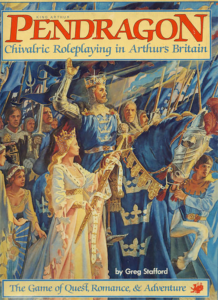
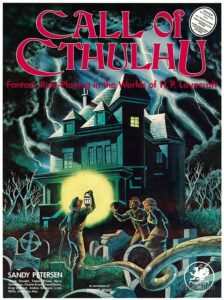
System crunch can be annoying, but can also underline what a game is about. Pendragon is probably a great example: some people might claim that they don’t need the Traits and Passions mechanics to “tell them how to roleplay“, and would rather play a game without that added sub-system. Of course, this extra bit of crunch is arguably what makes Pendragon such a great game, and a great example for mechanics reinforcing story tropes and vice-versa. Call of Cthulhu’s SAN mechanic is another such example.
Most games have all kinds of sub-systems we don’t necessarily think about until they’re absent: combat rounds (with their action economy), movement rules, damage rules, and character improvement rules are very common in every game.
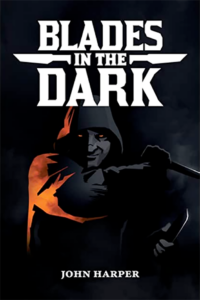


An example of high system crunch is RuneQuest: it has three resolution mechanics (roll under a characteristic multiplied by a difficulty factor, roll under a skill or trait modified by a bonus/penalty, or roll on the Resistance Table), at least two magic systems (spirit magic and rune magic, with sorcery as an optional third), Runes and Passions (with augment mechanics that aren’t even unified), attack/parry/dodge tables, fumble tables, hit locations with separate hit points, and more.
A lesser but still fairly high system crunch might be Blades in the Dark. It has resolution mechanics that include “position” and “effect”, fortune and resistance rolls, a bunch of tracks with their specific mechanics and effects (stress, reputation, heat, etc), crew mechanics, load-out and encumbrance, downtime, and so on. There’s a lot of moving parts. You might consider the engagement roll as an extra sub-system, but I’m on the fence about that, as it mostly re-uses the core mechanic.
On the other hand, most zine-like games would of course have low system crunch. For instance, Mausritter’s simple resolution mechanic, combat, and injury rules literally fit in 2 pages. Add a magic system, overland travel rules, and hireling rules for another handful of pages. That’s a very manageable number of moving parts.


The lowest system crunch is obviously a game that has, literally, just one system. Honey Heist has two stats (“Bear” and “Criminal”) and you roll under the one that fits the action you’re trying to attempt. The only other rule is the one about moving a point from one stat to another when certain conditions are met. All Outta Bubblegum is even simpler: there’s just one stat (the number of bubblegum sticks) and any action is done by rolling over or under it, depending on whether that action is “kicking ass” or not. Hard to find anything simpler!
But really, a lot of systems with a strong core mechanic tend to have moderately low system crunch too. Year Zero Engine, Savage Worlds, and GURPS get a lot of mileage from their basic resolution systems. GURPS Lite describes pretty much the entirety of GURPS’ core system in about 12 pages, without skipping much. GURPS Ultra-Lite simplifies combat and skips on details to fit it in one page. For a particular game, a few systems might be added as appropriate, such as Alien’s stress or Mutant Year Zero’s mutation mechanic. Slipstream gets space travel rules with “drift”, and activates some of Savage World’s optional rules like ship combat. GURPS might be played with or without hit locations, or Fright Checks, and so on. But all these systems tend to have only low-to-moderate crunch at their core… What about the Savage Worlds companions or the hundred of GURPS sourcebooks then? We’ll get back to that.
Silo Crunch
Silo crunch is a type of system crunch that is constrained into a specific category of play, that only some players experience (unlike system crunch, which is experienced by all). One typical silo crunch is class-based games in which each class has its own rules and complexity.
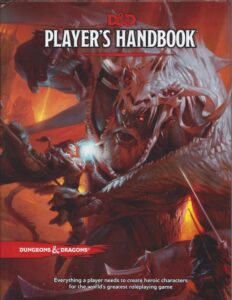
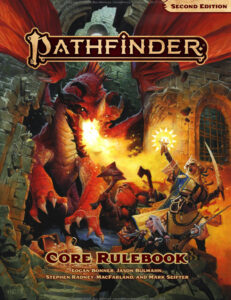
For example, D&D has a fair amount of silo crunch, with its many features and levels per class. It keeps things relatively simple by introducing that crunch bit by bit with every level. Pathfinder’s classes are probably crunchier. FFG’s Star Wars is also high on silo crunch, which its complicated talent trees for each career. Unlike D&D or Pathfinder, the average Powered by the Apocalypse playbook has all the class-specific moves enabled from the start, so the silo crunch is a bit higher at first but stays constant over time, since playbooks are generally fixed.
Silo crunch is probably my least favourite type of crunch. From a player’s point of view, it’s quite nice: you get a little “guided buffet” of options for your character and you can quickly attain some kind of system mastery if you limit yourself to a specific “silo”. But silo crunch is annoying (in my opinion) for gamemasters. GMs need to be aware of all the talents, features, moves, or powers of all character types. If they don’t know the special cool powers of the Ninja-Duck class, they won’t be able to present the Ninja-Duck character with interesting situations that can make use of these powers. That’s potentially a lot to keep in mind. And as a player, I don’t necessarily like to be confined to a limited number of archetypes anyway, but that’s another topic altogether.
Option Crunch
The last axis is option crunch, which is my favourite type of crunch. Unsurprisingly, this is the kind of crunch that GURPS is almost entirely built on. I like this crunch because it’s almost always derivative of the core mechanics and, as such, there is virtually no difference between the gamemaster taking a rule from a sourcebook, and the gamemaster improvising a rule on the fly from first principles.
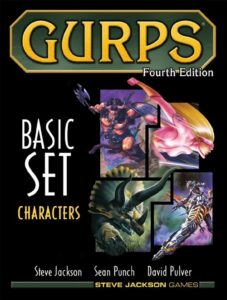

Remember that example about grappling rules that are a simple application of the core opposed roll mechanics? That’s what 95% of GURPS supplements are made of. GURPS Martial Arts defines “techniques” and new combat maneuvers that, frankly, boil down to point-buy modifiers for related abilities and bonuses/penalties to rolls. They don’t introduce any new mechanics or sub-systems, so they don’t increase the system crunch. If a player asks to poke an enemy in the eyes, the gamemaster can think about it for a second and say “get a -4 penalty, but on a success the enemy will be blinded for 2 rounds“. Good enough! If they had the “official” martial arts rules, they would see that the designers instead chose to give a -5 penalty, with the blinding duration determined by the margin of success, which is an interesting twist. But it’s all optional, and clearly stated as such. The gamemaster doesn’t need to spend any mental overhead on it while still allowing players to poke NPCs in the eyes.
Similarly, the Navigation rules in 50 Fathoms offer bonuses and penalties based on staying near the coast or being in the open sea, having a competent crew or not, or missing a compass. These are, again, modifiers that a gamemaster might be able to come up with on the fly instead, so there’s not much difference between using this optional crunch and winging it.
The value of these optional rules isn’t necessarily that someone put some thought into whether something is worth +2 or +3, but that someone put some thought into various considerations that might not occur to the players on the fly. Reading rules for fast-drawing swords in a samurai stand-off in GURPS Martial Arts, or for cabin fever in 50 Fathoms, can conjure up cinematic elements that the gamemaster might not have thought to include in the game otherwise.
Systems like GURPS and Savage Worlds also get a lot of mileage out of their systems of traits (advantages/disadvantages, or edges/hindrances). These generally boil down to a modifier to existing skills, or a new ability to be rolled against in specific situations. Again, this is something that works within the framework of the core mechanics, without creating a new sub-system. It’s great!
More Axes!
There might be other axes of crunch. Character creation crunch comes to mind: from those that only require rolling a few dice before getting underway to those that require two hours of life-path generation and many choices. I didn’t include it because it only happens once and I love a good session zero, but I know some people get frustrated if character creation passes the 20 minute mark. For these people, that axis might be important when gauging interest for a game.
Another might be “subjective mental overhead”, which has to do with how technically equivalent rules aren’t equivalent for some people. A common example is the vast number of people who somehow have trouble with roll-under systems vs roll-over systems, even though comparing numbers one way or another is mathematically equivalent. I also know about people who have trouble reading particular types of dice, such as D6 dice pools vs a single D20, or the whole side-debate about custom dice.
If I wanted to push the concept of crunch even further away from its traditional meaning, I might even add “social burden” to the mix. This is in light of the many games of the past decade or two that share narrative control and responsibilities across the players, as opposed to the traditional model in which this rests solely on the gamemaster’s shoulders. I know some players who, when asked to help “build the scene”, will frown and sigh as loudly as a free-form improv’ player being asked to count their arrows.
Get Rolling!
Well, that’s where I’m currently at in terms of thinking of crunch in roleplaying games. This is obviously my own mental framework, and I’m sure other people might have other ways to think about it! What’s yours?